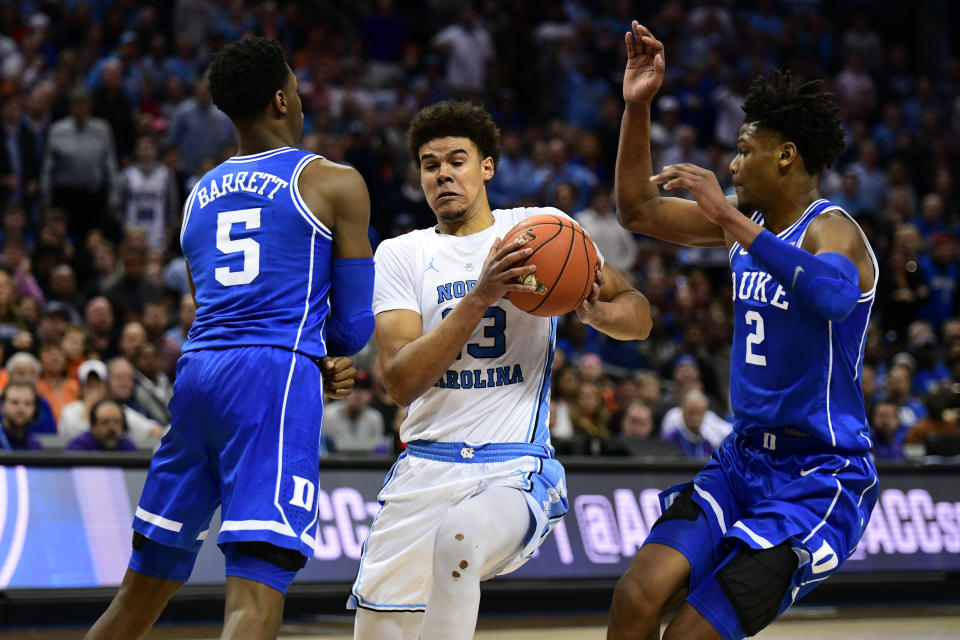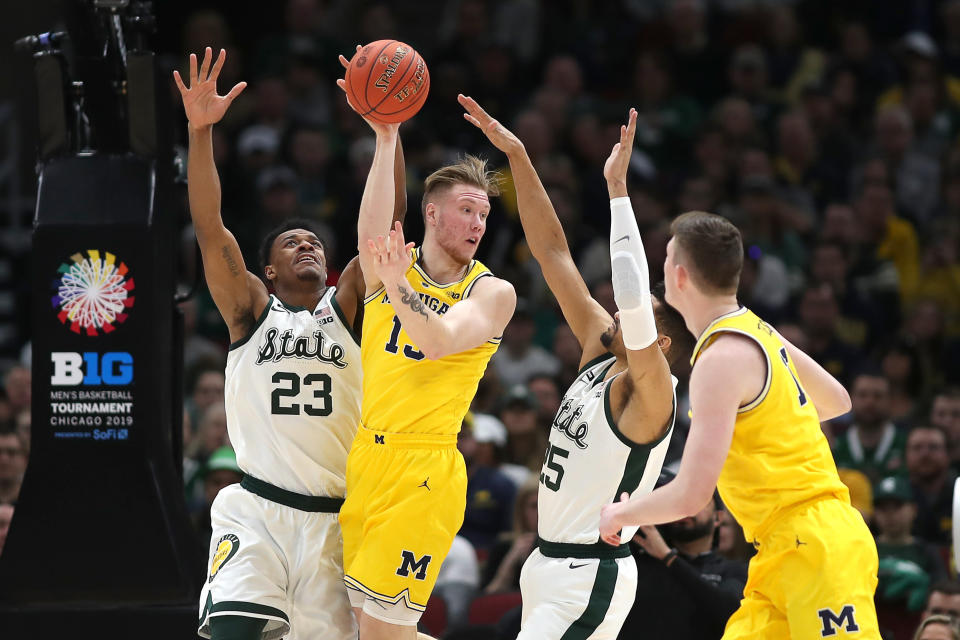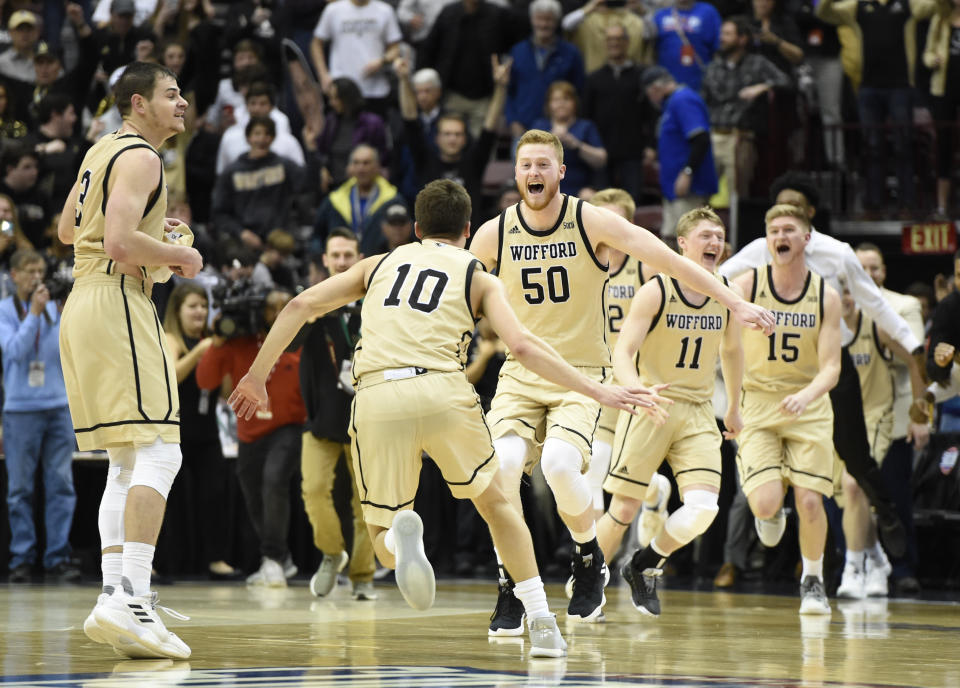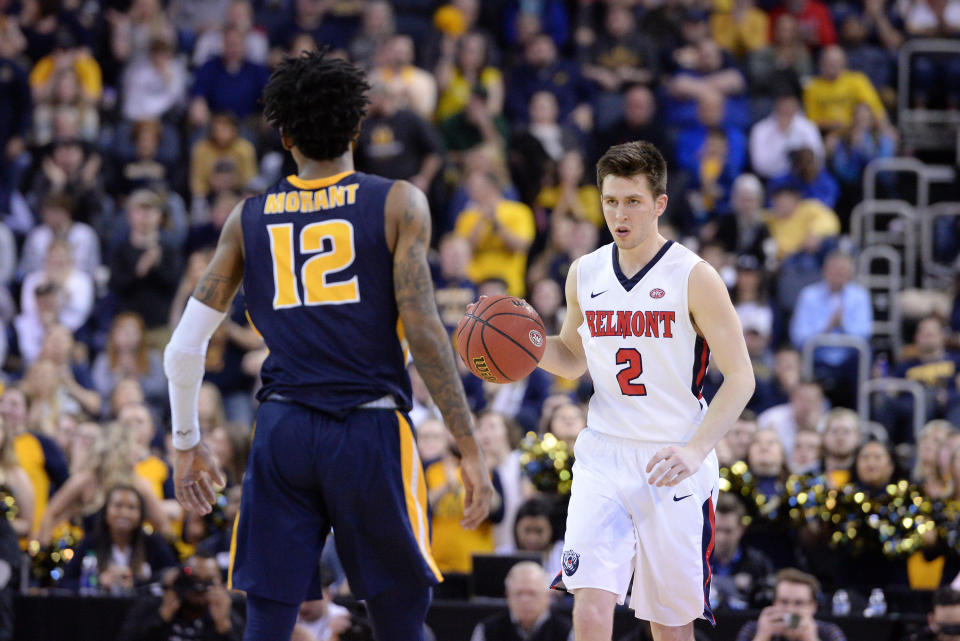Ranking the 2019 NCAA tournament contenders, from 1 to 68
We began with 353. Across 49 states and a federal district, 353 universities, teams, groups of kids and young adults, all with dreams.
They were partitioned into 32 conferences, as always, the idea to apportion excellence somewhat evenly over a broad landscape. And for decades, the conference concept had done just that. In the first 40 years of NCAA tournament seeding – a format introduced in 1978-79 – only once did a single league claim three No. 1 seeds. And none of the Big East’s three that year (2009) was the nation’s dominant team.
But in Season 41, the one whose March is about to get Mad, distributions skewed. Balance became imbalance. It was not a season-long storyline, because it was not a season-long trend. But heading into the 2019 NCAA tournament, for quite possibly the first time ever, the three best teams in college basketball come from a single conference: The ACC.
[Best bracket wins $1M: Enter our free contest now! | Printable bracket]
With 353 trimmed to 68, those three teams lead our now-annual 1-68 ranking of national championship contenders – grouped into 10 tiers, ordered from most to least likely to snip the nets in Minneapolis on April 8. They are North Carolina, Duke and Virginia, the top three overall seeds, the 2018-19 ACC Triumvirate. And they are Tier 1 of 10 – your 2019 NCAA tournament favorites.
Tier 1: The ACC Triumvirate
(Region, seed and first matchup in parentheses)
1. North Carolina (M1; vs. Iona) — On the surface, Carolina is admittedly a strange choice at No. 1. It has neither Duke’s star power nor Virginia’s numerical might, nor a win over either at full-strength. But these Tar Heels, more so than their fellow ACC rulers, were constructed to win six straight over three weekends against a diverse succession of challengers.
They are No. 1 because of variety and versatility; because they do so many things well that they can win without doing all of them well. They pound the offensive glass, but their offensive might is no longer reliant on it. They break off made baskets like Roy Williams’ best teams of the late 2000s did, and share the ball like the 2005 champs did. They have a two-big combo for every situation, a point guard who can score on anybody, an off-guard who can stop anybody, and a 6-foot-9 wing who can shoot over anybody. They have the ideal blend of youth and experience, an upward trajectory, and a Hall of Fame coach. They’re the complete package – and would be more widely recognized as such if they had simply hit five of their 26 3-point attempts in a one-point ACC semifinal loss to Duke instead of four.

2. Duke (E1; vs. play-in winner) — Of the 32 teams that have won national championships since the NCAA introduced the 3-point line in 1986, only six have made less than 35.5 percent of their long-range attempts. Only three have been below 34 percent. None has been worse than 32.9.
In other, simpler words: No team has ever won a national title shooting as poorly from the perimeter as the 2018-19 Duke Blue Devils.
Their 30.2 percentage from beyond the arc is the worst in the entire tournament, and is one of several Blue Devil flaws. Among the others are depth and youth. There are more reasons to feel uneasy about a team that will undoubtedly be America’s most popular title pick than many realize.
On the other hand, few players have ever masked flaws as convincingly as Duke’s rim-eviscerating, sprint-winning, rebound-gobbling, shot-swallowing, needle-threading human pogo/wrecking ball/brick wall Zion Williamson. He makes an absurd 76 percent of his 2-point field goals. He isn’t just the most hyped college basketball player in decades. He’s the most impactful, the clearest-cut National Player of the Year in some time, a supernatural force that can propel the ACC tournament champions to another, bigger crown.
3. Virginia (S1; vs. Gardner-Webb) — Have they evolved since last year’s nightmare? Slightly. Not much. (Yahoo Sports’ Jeff Eisenberg will have more on this later in the week.) But who says they have to in order to contend for a national title?
Even if you subscribe to the theory that the Cavs’ methodical style makes them more susceptible to upsets – the argument being that fewer possessions = fewer opportunities to exert superiority – that doesn’t apply beyond the NCAA tournament’s first weekend. So free your mind from recency bias. Escape thoughts of last year’s once-in-a-lifetime occurrence. Recognize that this is the best program in college basketball over the past six years, and have faith in Virginia.
Tier 2: The true contenders
4. Gonzaga (W1 vs. play-in winner) — With a full-strength Killian Tillie, this is the nation’s best frontcourt. And before a stunning WCC final loss to St. Mary’s, this was a Tier-1 team. Heck, it still might be. Oddsmakers say it is. Gone are the days of Gonzaga skepticism. An 89-87 November win over Duke – which felt like an NBA game in a high school gym – further squashed it. And Tillie returned from a foot injury last week, giving Mark Few his complete eight-man rotation for the Big Dance.
But the fact that the Zags have only played one tourney team since Dec. 15 isn’t irrelevant. When competition ramps up, can Brandon Clarke shoot 70 percent, and the collective a Division I-high 62.3 percent inside the arc? Can the guards puncture stronger defensive shells off the dribble? And can a team whose tallest healthy contributor is 6-foot-8 keep mammoth major-conference opponents off the glass? (Duke and North Carolina each rebounded more than 46 percent of their own misses against the Zags earlier this season.)
The point of asking those questions isn’t to presume negative answers. It’s to point out that there are, in fact, still questions, unanswered by WCC play. Gonzaga can win a national championship. But it hasn’t proven as much as the ACC Triumvirate.
5. Kentucky (M2; vs. Abilene Christian) — Can we, once and for all, bottle up the wrongheaded take that John Calipari is a great recruiter but mediocre basketball coach and launch that take into the sun?
There was a time not too long ago when this Kentucky team looked set to whiff on the lottery, and produce only one first-round NBA draft pick, for the first time under Coach Cal. And at that same time, the Wildcats did not look like true contenders. But the young core – PJ Washington, Keldon Johnson, Tyler Herro and Ashton Hagans – has developed as individuals and a unit. Kentucky is peaking at the right time. There’s no Anthony Davis- or Karl-Anthony Towns-level talent who would equate this year’s team to Calipari’s best. But the 2011 Final Four squad might be a decent comparison.
6. Tennessee (S2; vs. Colgate) — If you believe experience is necessary in March – and last year’s Final Four, with only three freshman starters across four participants, would support that belief – Tennessee is your squad. The top six players in Rick Barnes’ rotation are upperclassmen. The moxie that accompanies their maturity was on display in the last three minutes of an SEC semifinal that felt like a Final Four duel. The Vols erased an eight-point deficit to knock off Kentucky. And charismatic star Admiral Schofield’s message to his team in the midst of that comeback – “Why shy away now?” – might as well apply to Tennessee’s postseason run as well.
7. Florida State (W4; vs. Vermont) — The Seminoles are deep and balanced beyond belief. Eight players average at least six points per game, with the leader of the eight coming off the bench. They have a 7-foot-4 dude who moves decently; a skilled 6-foot-10 change-of-pace when the former doesn’t move well enough; a seemingly endless stable of long-tentacled wings who reach into offense’s dreams and make them nightmares; a couple of tough upperclassmen guards; and an underrated coach who’s 70 going on 50.
They’re one of two teams to beat Virginia (the other is the oddsmakers’ title pick). They’re 14-2 in their last 16. They’re a better, more seasoned version of last year’s Noles, who sunk top-seeded Xavier and Gonzaga. They’re a legitimate national title contender.
8. Michigan State (E2; vs. Bradley) —They’re big. They’re strong. They’re old. They’re tough. Unfortunately, they aren’t healthy. Junior center Nick Ward doesn’t yet look himself. There’s a Joshua Langford-sized hole in the wing rotation. And one of the players doing his best to fill it, Kyle Ahrens, was stretchered off during the Big Ten title game Sunday with an ankle injury. Sparty can hang with anybody in the country, and should still snap the longest second-weekend drought of Tom Izzo’s career. But it lacks the top gear of its Tier 1 and 2 brethren.

9. Texas Tech (W3; vs. Northern Kentucky) — An anomalous Big 12 quarterfinal loss to West Virginia aside, Tech played Final Four-caliber basketball over the season’s final month-plus. Already the nation’s most bucketproof defense, the Red Raiders scored 1.27 points per possession over their final seven regular-season games, which included a visit from Kansas and a trip to Iowa State. Chris Beard should be the coach of the year, Jarrett Culver will be a lottery pick, and shooters and shot-blockers surround him. The only reason for hesitancy: Tech hasn’t played a fellow Final Four contender since December.
10. Michigan (W2; vs. Montana) — The offense, statistically, is better than last season’s. Freshman Iggy Brazdeikis arrived as an already-certified baller. Zavier Simpson has reinvented the sky hook as a 6-foot, below-the-rim point guard. And the defense – the second-stingiest in Division I in adjusted efficiency terms, Michigan’s fourth consecutive year-over-year improvement – rubber-stamps John Beilein’s latest evolution as a coach.
The big difference, however, between this team and last year’s national runner-up is the absence of a big German. Mo Wagner was a matchup nightmare that forced opponents out of their defensive comfort zones. These Wolverines don’t have an individual who does that.
Tier 3: The fringe Final Four contenders
11. Virginia Tech (E4; vs. Saint Louis) — Senior point guard Justin Robinson – who’s been out since Jan. 30 with a foot injury – is back. At 100 percent? Unlikely. Even if he’s not himself, though ... doubt a water-bottle-karate-chopping coach and a 39.4-percent, high-volume 3-point shooting team at your own risk.
They don't call him Buzz KARATE MAN Williams for nothin' pic.twitter.com/rO4R1cVQ9O
— Highlights on Loop (@LoopedReplay) March 14, 2019
12. Purdue (S3; vs. Old Dominion)
13. Auburn (M5; vs. New Mexico State) — The eye test labels the Tigers “streaky as hell.” The numbers connect the dots. Bruce Pearl’s guard-oriented team launches almost 50 percent of its field goals from beyond the 3-point line – and makes 38 percent of them. It also forces turnovers more often than anybody else in the country, on more than a quarter of opponent possessions. Two high-variance strategies producing frequent fluctuations in performance? Yep, checks out.
So when Auburn is good, as it was at the SEC tournament, it’s really good. And when it’s not? No need to go there, because these rankings are about ceilings, not floors. Auburn’s is high.
14. Houston (M3; vs. Georgia State) — Last year’s Cougs were a 30-foot buzzer-beater away from halting Michigan’s run to the national championship before it really got started. This year’s Cougs lost two of their top three scorers … and got better.
15. Kansas (M4; vs. Northeastern) — All five starters, and seven of nine rotation players, are newcomers. Would-be cornerstones are injured (Udoka Azubuike), ineligible (Silvio De Sousa) and no longer with the team (Lagerald Vick). The byproduct of the upheaval was the end of the streak, and is, frankly, an inconsistent, mediocre-by-Jayhawk-standards team – because it’s a team Bill Self never expected to put on the floor.
16 Kansas State (S4; vs. UC Irvine) — Dean Wade’s status – questionable with a foot injury – significantly mutes K-State’s upside. The Wildcats can win without him, as they did en route to last year’s Elite Eight. But the 6-foot-10 stretch five – the team’s best shooter, and arguably its best facilitator – makes the (104th-ranked) offense far more potent.
Tier 4: The wiretapped
17. LSU (E3; vs. Yale) – On the eve of its outright SEC regular-season title clincher, LSU suspended head coach Will Wade after a Yahoo Sports report revealed the FBI had intercepted calls between Wade and a middleman discussing a “strong-ass offer” for a recruit. That recruit, (presumably) current Tiger guard Javonte Smart, was held out of one game, but returned for the SEC tournament. The Wade situation, however, remains at a standstill.
How will it affect the Tigers in the NCAA tourney? That’s anybody’s guess. For what it’s worth, LSU lost its SEC quarterfinal to unranked Florida. Interim coach Tony Benford, in his only prior head coaching gig, never finished above .500 in five seasons at North Texas. And these Tigers weren’t as good as their outright conference title would suggest in the first place. They won it with offense, and their offense sustains itself on ferocious rebounding. Keep them to one shot – as Yale might just be able to do – and they’re a relatively ordinary team.
Tier 5: The lurkers
18. Iowa State (M6; vs. Ohio State) — If the Cyclones can win two games and get to Hilton South – the site of their Big 12 tournament triumph – for the regional … watch out.
19. Villanova (S6; vs. Saint Mary’s) — Buried beneath the many glorious offshoots from last year’s triumph was an inconvenient one: The players expected to step from secondary roles into primary roles stepped instead to the NBA. The departures of Omari Spellman and Donte DiVincenzo accelerated the developmental treadmills under the entire roster. Those two were supposed to be the guys; instead, the guys are last year’s fifth and sixth options. The Wildcats have neither the talent nor the polish required for a repeat run.
20. Wofford (M7; vs. Seton Hall) — Fletcher Magee might be the greatest shooter in college basketball history. At the very least, he’s currently the closest thing college hoops has to JJ Redick. And … uh … his team’s 3-point percentage (41.6) is higher than his (41.3).
Seriously.

21. Buffalo (W6; vs. Arizona State/St. John’s) — Yahoo Sports’ Pete Thamel wrote a fantastic feature on Bulls head coach Nate Oats, who six years after teaching high school math is one of the hottest commodities in college basketball. And his trio of seniors, led by CJ Massinburg, will make 30-win Buffalo a tough out.
22. Nevada (W7; vs. Florida) — The Pack have played one tournament team all year. Their reputation continues to live off last year’s inconceivable comeback against Cincinnati and a preseason top-10 ranking. They’ll go as the Martin twins and Jordan Caroline go, which will be fast and furious, but could very well result in a first-round wreck.
23. Louisville (E7; vs. Minnesota) — Not only did the NCAA (break bracketing principles to) give us Kid Pitino vs. School That Fired Dad Pitino In Disgrace. It conveniently put it at 12:15 ET on Thursday – 6:15 Eastern European Time – all but asking Rick to auction off an all-expenses-paid trip to Greece to watch the game with him. All proceeds go to charity. Guarantee the bidding would reach five figures.
24. Wisconsin (S5; vs. Oregon) — Ethan Happ is one of the best players in college basketball – and has been since the Obama presidency. The 6-foot-10 senior is the best, according to Ken Pomeroy’s ratings. But he’s also one of the most perplexing. He’s not significantly better than his sophomore self. He’s had a few stinkers in February and March. He’s deteriorated as a shooter rather than improved. And his 46.5-percent free-throw mark makes him a liability in crunch time. Greg Gard occasionally has to bench his offense’s focal point late in close games. That’s a recipe for March Sadness.
Tier 6: Boeheim in March
25. Syracuse (W8; vs. Baylor) — Jim Boeheim has, somewhat secretly, been a very ordinary regular-season coach over the past five years. His teams have been shallow and inconsistent. Their average ACC finish over that span? Ninth, at 9-9.
Yet Boeheim hasn’t lost a first-round NCAA tournament game since 2006. The five superficially middling years have yielded multiple March upsets, two Sweet 16s and a Final Four. There are logical explanations – the zone that befuddles unfamiliar opponents on short notice, for example; and Boeheim’s record in close games. But just as convincing is some strange, intangible Orange voodoo that, for example, made Michigan State shoot 17-of-66 in last year’s Round of 32. Syracuse hasn’t been a better team than a few immediately below it on this list. But it’s Syracuse.
Tier 7: Meh
26. Florida (W10; vs. Nevada) — The Gators looked like a Sweet 16 squad in Nashville. And in two losses to close the regular season. And at various other points throughout a disappointing but deceiving 15-loss season. The two-senior, three-frosh backcourt rotation could spur a second-weekend run.
27. Cincinnati (S7; vs. Iowa)
28. Mississippi State (E5; vs. Liberty)
29. Maryland (E6; vs. Belmont/Temple)
Tier 8: Major mediocrity, mid-major intrigue
30. Marquette (W5; vs. Murray State) — Before losing five of six to close the season, the Golden Eagles were overrated. Now they’re just … uh, how should we say this … not very good.
31. Utah State (M8; vs. Washington)
32. Minnesota (E10; vs. Louisville) — The day Richard Pitino made 6-foot-8 junior Amir Coffey a point guard is the day Minnesota became a problem. Unfortunately, Coffey has only one (1) 30-percent-or-better 3-point shooter around him.
33. Baylor (W9; vs. Syracuse)
34. Seton Hall (M10; vs. Wofford)
35. VCU (E8; vs. UCF) — Leading scorer Marcus Evans is expected to play after leaving VCU’s A-10 quarterfinal loss with a knee injury. With or without him, this will not be a pleasant two hours for UCF. The Rams guard like their lives depend on it.
36. Ole Miss (S8; vs. Oklahoma)
37. St. Mary’s (S11; vs. Villanova)
38. Oregon (S12; vs. Wisconsin) — A week ago, the Ducks weren’t anywhere near the tourney. Now they’re 1-point favorites over Wisconsin! (Ken Pomeroy has the line at Wisconsin -5, the second-largest disparity between his numbers and oddsmakers.)
39. UCF (E9; vs. VCU) — Seven-foot-6 Tacko Fall’s tourney debut – Friday at 9:40 ET, unfortunately – is must-watch television. VCU’s tallest starter is 6-foot-8.
40. Ohio State (M11; vs. Iowa State)
41. New Mexico State — The Aggies play 10 guys, bombard the offensive and defensive boards, and are growing antsy for a tourney win. This is their ninth invite to the Big Dance since 2007. They’ve yet to score a second date.
42. Oklahoma (S9; vs. Ole Miss)
43. Belmont (E11; First Four vs. Temple) — Rick Byrd has won 804 career games … and zero in the Division I NCAA tournament. That changes on Tuesday!
44. Iowa (S10; vs. Cincinnati)
45. Murray State (W12; vs. Marquette) — The Smart Basketball Man take is that this is “more than a one-man team.” But … nah. If there’s a one-man team in the 2019 NCAA tournament, it’s the Racers. (And that one man is Ja Morant, whose name you’ll hear a lot this week, over the next few months, and possibly over the next decade.)

46. Arizona State (W11; First Four vs. St. John’s)
47. Vermont (W13; vs. Florida State) — A popular upset pick spoiled by a brutal draw.
48. Temple (E11; First Four vs. Belmont)
49. Washington — I will unrelentingly stan for this year’s Pac-12 over the 2011-12 mess as the worst power conference ever. Three bids flattered it. It was hideous. (As is Washington’s offense.)
50. Yale (E14 vs. LSU) — No. 1 on our list of potential Cinderellas – a list that led with Loyola last year.
51. St. John’s (W11; First Four vs. Arizona State)
52. Liberty (E12; vs. Mississippi State) — Junior forward Scottie James: excellent at basketball, not so excellent at the late-second-half #NeymarChallenge:
Liberty guy out here with the worst acting I've seen since Weekend at Bernie's II. Credit to the refs for not falling for it pic.twitter.com/t84MUKPmnf
— Aaron Torres (@Aaron_Torres) March 10, 2019
53. UC Irvine (S13; vs. Kansas State) — Irvine’s top scorer in a Big West final blowout of Fullerton? His last name is Welp, and he looks like the high school math whiz whose friends convinced him to play JV to make up numbers. Except he’s 6-foot-9 and can ball. As can the five upperclassmen who comprise the starting lineup. The Anteaters are potentially frisky.
54. Northeastern (M13; vs. Kansas) — Not going to ask you to remember the name Vasa Pusica, or to type it into a search bar just yet. But make mental note; register it; store it away, just in case.
Tier 9: Long-shot Cinderellas
55. Saint Louis (E13; vs. Virginia Tech)
56. Georgia State (M14; vs. Houston) — Four experienced 40-plus percent 3-point shooters around lead guard D’Marcus Simonds sounds like a recipe for an upset. Houston, beware.
57. Northern Kentucky (W14; vs. Texas Tech)
58. Old Dominion (S14; vs. Purdue)
59. Montana (W15; vs. Michigan)
60. Bradley (E15; vs. Michigan State) — Barred (and later reversed course under media pressure) a longtime beat reporter for “not promoting the Bradley brand” – which, uh, was non-existent until the petty ploy! So … congrats, Bradley! You now have a brand!
61. Colgate (S15; vs. Tennessee)
Tier 10: No-shot Cinderellas
62. Gardner-Webb (S16; vs. Virginia)
63. Iona (M16; vs. North Carolina)
64. North Dakota State (E16; First Four vs. NC Central)
65. Abilene Christian (M15; vs. Kentucky)
66. Fairleigh Dickinson (W16; First Four vs. Prairie View A&M)
67. Prairie View A&M (W16; First Four vs. Fairleigh Dickinson)
68 North Carolina Central (E16; First Four vs. North Dakota State) — The upset of Norfolk State that punched Central’s ticket was its first win over a KenPom top-300 foe all season. And that would include any intrasquad scrimmages. The Eagles themselves rank 303.
– – – – – – –
Henry Bushnell is a features writer for Yahoo Sports. Have a tip? Question? Comment? Email him at henrydbushnell@gmail.com, or follow him on Twitter @HenryBushnell, and on Facebook.
More NCAA tournament coverage on Yahoo Sports:

 Yahoo Sports
Yahoo Sports 

